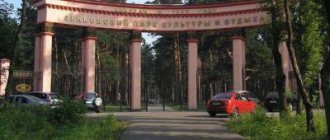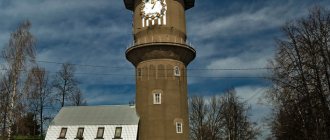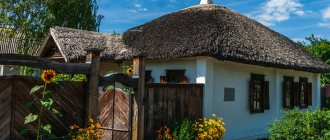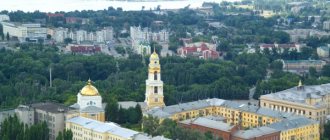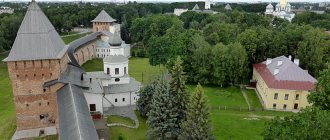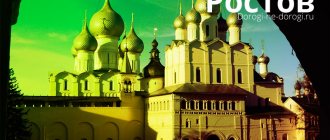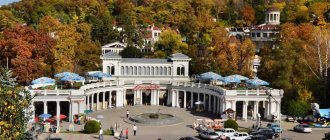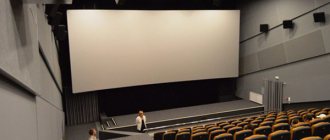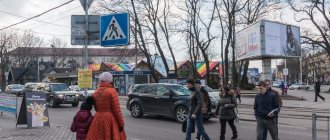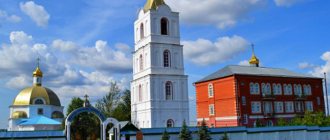| City | |
| Kokhma | |
| Flag | Coat of arms |
Moscow
Ivanovo
Kokhma
Media files on Wikimedia CommonsKokhma
- a city (since 1925[2]) in the Ivanovo region of Russia.
As part of the organization of local self-government, it forms the Kokhma urban district
[3]. Within the administrative-territorial structure of the region, it is a city of regional subordination[4]. Previously it was taken into account as part of the Ivanovo district.
Population - 30,336[1] people. (2021).
History[ | ]
First mentioned as the village of Rozhdestveno-Kokhma
.
The first name is from the church in the name of the Nativity of Christ, which has long existed in the village. The second name, apparently, comes from the ancient, pre-Russian name of the area Kokhma
[5].
At the end of the 16th and beginning of the 17th centuries, the villages of Ivanovo and Kokhma, which were part of the Kokhomskaya volost, were the patrimony of the Skopins-Shuiskys. Acts of the late 1610s - early 1630s record the villages of Ivanovo and Kokhma in the possession of princesses Anna Petrovna and Alexandra Vasilievna Skopin-Shuisky, mother and wife of Mikhail Vasilyevich Skopin-Shuisky. According to the will of the “elder princess Anisya Petrovna” Skopina, Ivanovo and its villages went to Ivan Ivanovich Pugovka-Shuisky, the last representative of the Shuisky family, and Kokhma - to the house of the Suzdal archbishops[6].
In 1619 it was mentioned in documents as the village of Rozhdestvenskoye-Kokhma. At the beginning of the 18th century, the village was under the jurisdiction of the Monastic Prikaz and was the patrimony of the Suzdal bishop.
In 1719, the village was assigned to the linen manufactory of the Dutch merchant I. Tames, which was built here in 1720. Tames pointed out that “ this volost is very suitable for that manufacturing structure, since before that volost the peasants with their wives and children are very good at that building with their craftsmanship and yarn.”
»[7].
In 1822, the calico-printing manufactory of V.N. and E.N. Yasyuninsky was founded in the village.
In 1826-1828 in Kokhma there were 5 calico printing and 4 linen establishments (employing 149 people). In the mid-1850s, Kokhma was a large industrial village. In it and the villages surrounding it, in addition to the factory of V.N. Yasyuninsky, there were over 20 calico-printing, calico weaving and linen establishments[7].
According to information for 1859, there were 1,125 people in the village of Kokhma. residents, 237 households, 3 churches, 4 factories[8].
City status since 1925. In 1935-1948, Kokhma was the center of the Kokhomsky district, then it belonged to the Ivanovo district. The modern city border was approved on November 17, 1995.
Since 2005, within the framework of the organization of local self-government, the Kokhma urban district
or
the city of Kokhma
as the only populated area in its composition[3]. Within the administrative-territorial structure of the region, it is a city of regional subordination[4]. According to OKATO, it was located on the territory of the Ivanovo district[4], but in the collection as of January 1, 2001, it was excluded from the district[9], while Rosstat, before the 2010 census, took it into account as part of the district[10][11].
Yasyuninsky Estate
There is another building in the city that once belonged to the merchant Vasily Nikitich Yasyuninsky. This is a family estate with an observatory on the roof, where the merchant’s children and grandchildren subsequently lived and watched the stars. Later, the building housed the local district party committee, a newspaper editorial office and printing house, a technical school, a boarding school, a school for working youth and, finally, an art school, which still operates to this day.
Location: Ivanovskaya street - 8.
Population[ | ]
| Population | ||||||||
| 1859[12] | 1897[13] | 1905[14] | 1931[15] | 1939[16] | 1959[17] | 1967[15] | 1970[18] | 1979[19] |
| 1125 | ↗3337 | ↗5663 | ↗13 600 | ↗18 983 | ↗20 252 | ↗22 000 | ↗22 323 | ↗25 239 |
| 1989[19] | 1992[15] | 1996[15] | 1998[15] | 2001[15] | 2002[10] | 2003[15] | 2005[15] | 2006[15] |
| ↗26 831 | ↗27 000 | ↗27 300 | ↗27 600 | ↗28 500 | ↗28 761 | ↗28 800 | ↘28 600 | →28 600 |
| 2007[15] | 2009[11] | 2010[19] | 2011[15] | 2012[20] | 2013[21] | 2014[22] | 2015[23] | 2016[24] |
| →28 600 | ↘28 591 | ↗29 411 | ↘29 400 | ↗29 414 | ↘29 405 | ↘29 389 | ↘29 258 | ↗29 770 |
| 2017[25] | 2018[26] | 2019[27] | 2020[28] | 2021[1] | ||||
| ↗30 316 | ↗30 500 | ↘30 220 | ↘30 161 | ↗30 336 | ||||
As of January 1, 2021, in terms of population, the city was in 496th place out of 1,116[29]cities of the Russian Federation[30].
Barracks with People's House
These barracks were built specifically for single factory workers. In addition to the housing itself, there was a dining room and a library. As well as a theater, which occupied the entire top floor and included a large auditorium with a stage, dressing rooms and warehouses for props.
The theater was highly valued by factory owners; it had its own troupe consisting of workers. This is also evidenced by the fact that on the central facade of the barracks there is the inscription “THEATRE”. Another grandson of the merchant Yasyuninsky, namely Nikolai Arsenievich, had a hand in his appearance.
After the revolution of the seventeenth year, no one lived in the barracks building, but various organizations were located. At first there was a club for one of the city's enterprises, then a school, a hospital and a district hospital, and today it is just an ancient monument.
Location: Ivanovskaya street - 36.
Notes[ | ]
- ↑ 123
The permanent population of the Russian Federation by municipalities as of January 1, 2021 (Russian). Date accessed: April 27, 2021. Archived May 2, 2021. - THE USSR. Administrative-territorial division of the union republics on January 1, 1980 / Comp. V. A. Dudarev, N. A. Evseeva. - M.: Izvestia, 1980. - 702 p. — P. 122.
- ↑ 12
Charter of the Kokhma urban district - ↑ 123
Register of geographical names of settlements registered in AGKGN as of 03/23/2021 Ivanovo region of the State Catalog of Geographical Names (Rosreestr) - Pospelov E.M.
Geographical names of the world: Toponymic dictionary. - M.: Russian dictionaries, 2002. - P. 219. - 512 p. — ISBN 5-93259-014-9. - The patrimony of the hero of the Time of Troubles (undefined)
(inaccessible link). Access date: October 25, 2011. Archived November 11, 2014. - ↑ 1 2 Vodarsky Ya. E.
Formation of the factory town of Kokhma - "Vladimir province. List of populated places according to information from 1859”, St. Petersburg, 1863 [1]
- Ivanovo region. Administrative division as of January 1, 2001
- ↑ 1 2
All-Russian population census of 2002.
Volume. 1, table 4. Population of Russia, federal districts, constituent entities of the Russian Federation, districts, urban settlements, rural settlements - regional centers and rural settlements with a population of 3 thousand or more (unspecified)
. Archived from the original on February 3, 2012. - ↑ 1 2
Number of permanent population of the Russian Federation by cities, urban-type settlements and regions as of January 1, 2009
(unspecified)
. Retrieved January 2, 2014. Archived January 2, 2014. - Lists of populated places of the Russian Empire. VI. Vladimir province. According to information from 1859 / Processed by Art. ed. M. Raevsky. — Central Statistical Committee of the Ministry of Internal Affairs. - St. Petersburg, 1863. - 283 p.
- Populated areas of the Russian Empire with 500 or more inhabitants, indicating the total population present in them and the number of inhabitants of the prevailing religions, according to the first general census of 1897 - printing house "Public Benefit". - St. Petersburg, 1905.
- List of populated places in the Vladimir province. — Central Statistical Committee of the Ministry of Internal Affairs. — Vladimir, 1907.
- ↑ 1 2 3 4 5 6 7 8 9 10 11
People's encyclopedia “My City”.
Kokhma (undefined)
. Retrieved July 2, 2014. Archived July 2, 2014. - All-Union Population Census of 1939. The size of the urban population of the USSR by urban settlements and intra-city areas (unspecified)
. Retrieved November 30, 2013. Archived November 30, 2013. - All-Union Population Census of 1959. The size of the urban population of the RSFSR, its territorial units, urban settlements and urban areas by gender (Russian). Demoscope Weekly. Access date: September 25, 2013. Archived April 28, 2013.
- All-Union Population Census of 1970 The size of the urban population of the RSFSR, its territorial units, urban settlements and urban areas by gender. (Russian). Demoscope Weekly. Access date: September 25, 2013. Archived April 28, 2013.
- ↑ 1 2 3
Results of the All-Russian Population Census of 2010, volume 1. Number and distribution of the population of the Ivanovo region
(unspecified)
. Date accessed: March 30, 2021. - Population of the Russian Federation by municipalities. Table 35. Estimated resident population as of January 1, 2012 (unspecified)
. Retrieved May 31, 2014. Archived May 31, 2014. - Population of the Russian Federation by municipalities as of January 1, 2013. - M.: Federal State Statistics Service Rosstat, 2013. - 528 p. (Table 33. Population of urban districts, municipal districts, urban and rural settlements, urban settlements, rural settlements) (undefined)
. Retrieved November 16, 2013. Archived November 16, 2013. - Table 33. Population of the Russian Federation by municipalities as of January 1, 2014 (unspecified)
. Access date: August 2, 2014. Archived August 2, 2014. - Population of the Russian Federation by municipalities as of January 1, 2015 (unspecified)
. Access date: August 6, 2015. Archived August 6, 2015. - Population of the Russian Federation by municipalities as of January 1, 2021 (Russian) (October 5, 2018). Date accessed: May 15, 2021. Archived May 8, 2021.
- Population of the Russian Federation by municipalities as of January 1, 2021 (Russian) (July 31, 2017). Retrieved July 31, 2021. Archived July 31, 2021.
- Population of the Russian Federation by municipalities as of January 1, 2021 (Russian). Retrieved July 25, 2018. Archived July 26, 2021.
- Population of the Russian Federation by municipalities as of January 1, 2021 (Russian). Date accessed: July 31, 2019. Archived May 2, 2021.
- Population of the Russian Federation by municipalities as of January 1, 2021 (Russian). Date accessed: October 17, 2021. Archived October 17, 2021.
- taking into account the cities of Crimea
- https://rosstat.gov.ru/storage/mediabank/bul_Chislen_nasel_MO-01-01-2021.rar Population of the Russian Federation by municipalities as of January 1, 2021 (1.85 Mb, 07/30/2021)
- OGOI "Kokhom boarding school of the VI type" - Ivanovo region (unspecified)
(inaccessible link -
history
). - Under the green star of Esperanto.
- HOSPITALS AND MEDICAL BATHS – Genealogical forum of the IOP
- https://www.soldat.ru/hospital.html
Administration building
One of the grandsons of Vasily Nikitich, namely Vasily Arsenievich, at the very beginning of the twentieth century, built another estate in the city, consisting of a residential building, a gate, a fence and stables with a carriage house.
Initially, he planned to settle in the estate himself, but something didn’t work out, and he began to rent it out. Until 1917, the German colorist Metzger lived there with his family, and after the revolution the City Council settled there. From 1998 to the present day, the administration of Kokhma is located in the estate of V. A. Yasyuninsky.
Location: Sovetskaya street - 23.
Temples and chapels
At the beginning of the 20th century, there were five Orthodox churches in Kokhma, as well as a number of chapels, which at that time were the main architectural and cultural decoration of the city. It would be great to look at them, but, unfortunately, at the end of the same century they were destroyed for a number of reasons. But new ones appear, no less beautiful and interesting. For example, the Holy Annunciation Church (1 Oktyabrskaya St., pictured above), which began construction in 1998 and was consecrated in 2011.
On the ground floor of the temple there is a kind of museum, or rather a “Spiritual and Educational Center”. Curious and rare exhibits are exhibited there - ancient church utensils and vestments of clergy stitched with gold threads, silver coins, historical books, documents and much more. It's worth a visit, very interesting and unusual. The city also has the Chapel of the Icon of the Mother of God “Quench My Sorrows” (13 Rabochaya Street, pictured above), built and consecrated a little earlier, namely in 1997.
Naboynaya Manufactory
Another oldest representative of the architectural and historical heritage of Kokhma is the printing manufactory building, built at the turn of the 18th and 19th centuries. It was part of a complex of factory buildings owned by the Chernyshev merchants, which is why city residents call this place “Chernyshevsky Dvor”.
Location: Oktyabrskaya street - 30.
